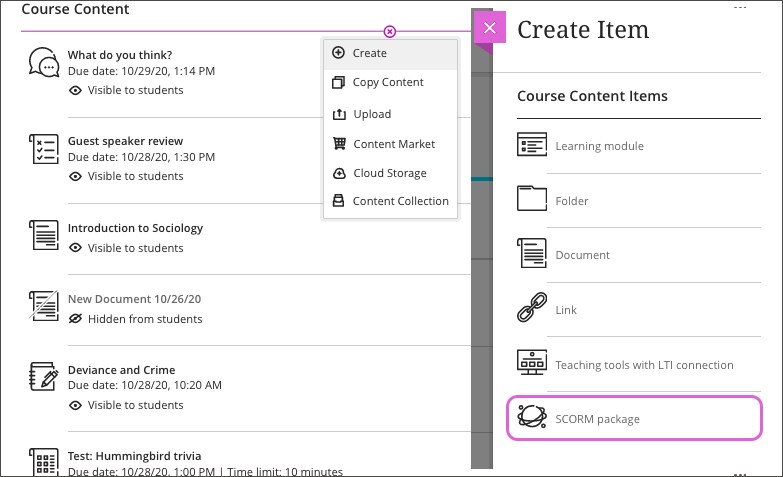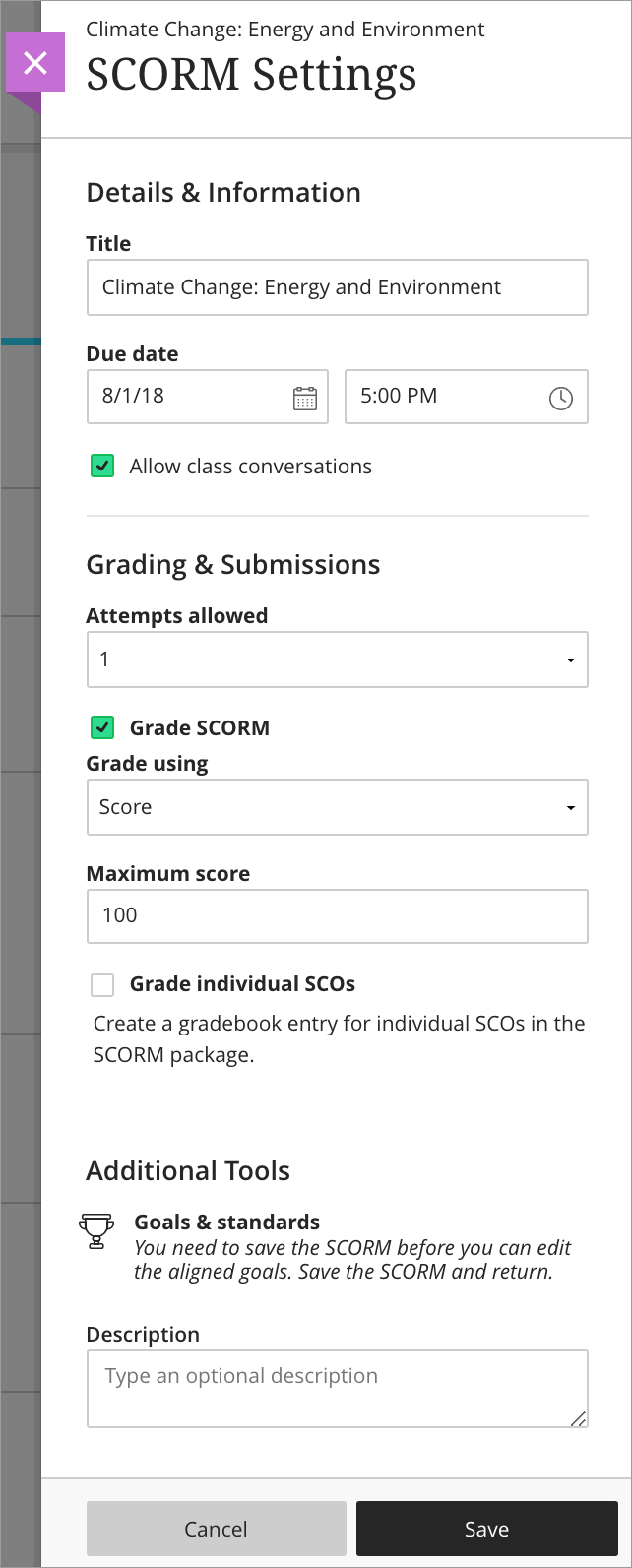This guide pertains to Ultra Course View.
If your course is in Original Course View, see the Original Course View tutorial collection.
SCORM Overview
A type of web-based learning content you can use in your course is called an SCO, or Shareable Content Object. These SCOs are gathered together into a compressed ZIP file called a content package. The zipped file can be unpackaged and played through a content player. Typically, individual components or entire packages are provided to you by publishers, commercial companies, or other sources.
Advanced setting options appear for instructors when they add a SCORM package to their course. After students submit SCORM attempts, instructors can view detailed reporting on time spent, average score, and attempts completed.
Add a SCORM Content Package
Add a SCORM package to your course the same as any other piece of content.
- On the Course Content page, select the purple plus to add content.
- In the menu, select Create to open the Create Item panel. Select SCORM package.
- In the SCORM Settings panel, select Upload SCORM package or Browse Content Collection.
- Locate and select the SCORM package to upload.
After the file has been uploaded and checked, the SCORM Settings panel appears where you can set the content package details.

- In the Details & Information area, type a Title and select a Due date. You can also allow class conversations for students to have quick exchanges about the SCORM package.
- In the Grading & Submissions area, select the Grade category and number of Attempts allowed. By default, a graded SCORM with multiple attempts uses Last attempt with a grade to determine the final grade. You can't change this setting.
- Select Grade SCORM to add a Gradebook entry for the package. Select the Grading Schema and Maximum Score. Grade settings cannot be changed after you import the SCORM.
- Select Grade Individuals SCOs to add a Gradebook entry for selected parts of the SCORM package. When you select this option, the list of SCOs within the package appears. For each SCO you select, you can also select the Grading Schema and Maximum Score.
Hover on a SCO in the list to reveal the Edit icon, represented by a pencil. Select the icon to rename the SCO.

- When you grade individual SCOs, the Reveal Grade option appears. You can reveal the grade to students after SCORM completion.
- Optionally, type a Description.
- Select Save to finish the import.
After you import the SCORM package, you can change its visibility, align goals, and edit other settings. You won't be able to change grading options after you import the SCORM package.
Delete a SCORM Package
You can delete a SCORM package from your course and if no student submissions exist, the Gradebook item is also deleted. For SCORMs with submissions, you must confirm that you want to permanently remove the SCORM, all submissions, and grades from your course.
Or, hide the SCORM from students to preserve the submissions and the scores in the Gradebook. Students can't access hidden content on the Course Content page or on their grades pages even if you've graded submissions.
SCORM Settings
You can edit SCORM settings from the Course Content page and the Gradebook. Open the menu and select Edit to open the settings. From the Grades & Submissions page, select the gear icon.

Show or hide the SCORM package. Students can't see a SCORM package until you choose to show it. You can create all your content ahead of time and choose what you want students to see based on your schedule. You can also set availability conditions based on date, time, and performance on other items in the course Gradebook. On the Course Content page, students can see when you set the SCORM to show.
Allow class conversations in case your students have questions about a SCORM package. As the conversation develops, it appears only with the relevant content.
Change the grade category. You can change the SCORM's grade category to be part of one of the custom Gradebook categories you set up in your course. You can create new categories to customize how coursework is grouped in your course. Custom categories can be useful when you set up the overall grade.
Determine the number of attempts. You can let your students submit more than one attempt at a SCORM.
By default, a graded SCORM with multiple attempts uses Last Attempt with a grade to determine the final grade. You can't change this setting.
Add goals and standards. You can align a SCORM package to one or multiple goals. Goals, which measure student achievement across programs and curriculums, are set by the department and are not in use at this time.
Add an optional description. The description appears with the SCORM title on the Course Content page.
You can't change the grade schema or maximum score after you import a SCORM package. To change the grade schema or maximum score, you'll need to delete the SCORM and reimport it.
Grades & Submissions Page

Keep track of all submissions on one page. Quickly see which attempts are ready to grade. Student profile pictures appear with a red circle when they have late attempts or the due date has passed with no attempt submitted.
Preview the SCORM. Before you begin grading, you can review SCORM content. Select Preview SCORM to launch the package and browse through the content.
Toggle the Submission list. Quickly flip between graded items within the SCORM package. You can select individual SCOs from the list if you chose to grade them on SCORM import.
See SCORM Analytics to learn more about the reports available regarding your SCORM content and student performance.